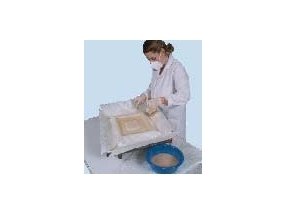|
Optimold Tooling Resin
A rapid curing dimensionally stable resin, especially formulated for the production of GRP moulds.
In stock |
|
| Click image to enlarge |
| 1 x 25kg | 2 x 25kg | 4 x 25kg | 10 x 25kg |
| £115.00 | £220.00 | £420.00 | £975.00 |
Prices do not include VAT
OPTIMOLD
OPTIMOLD Rapid Tooling System is a resin specifically designed for tool manufacture with a rapid build-up of laminate layers and reduced shrinkage. The system benefits from superior dimensional stability and reduced fibre print through when compared to traditional tooling methods.
Before Use
The material has a shelf life of 2 months. To gain the full benefits of the system, the pre-packaged material must always be mixed before use.
The resin must be conditioned to at least 20°C before use and the workshop and master plug temperature must not be below 15°C.
The Method
Gelcoat the master mould in the traditional way with a Vinylester tooling gel coat.
It is recommended that a skin coat of 150g matt is first applied using a Vinylester resin and allowed to cure.
Cut the required number of glass fibre layers to give approx, 5-6mm laminate and decant the required weight of OPTIMOLD to give a resin: glass ratio of approx 3.5 : 1. This amount of material should be split into smaller portions and catalysed when required if the pot-life is shorter than the time taken to laminate the part (see minimum catalyst level recommended)
Catalyse the resin at a level of 15g per Kg using a MEKP medium activity catalyst (*see pot life information). On no account should the catalyst level fall below 12g per Kg or exceed 25g per Kg. Laminate the glass layers paying particular attention to the first layer around radii and on vertical areas. Trapped air, dry
Patches and glass “sitting up” must be fully consolidated before the second layer is applied.
Produce the first 5-6mm laminate in one application and allow the exotherm to start. The exotherm is a vital part of the cure and when achieved successfully, a colour change from beige to white will be detected in the laminate. During the exotherm stage the laminate must achieve a minimum temperature of 40°C in practice temperatures well in excess of this are normal. When a thicker build is required, further layers should be applied one the exotherm has subsided, but it is not necessary for the laminate to be “cold”.
If there is any doubt regarding the exotherm achieved during manufacture, or if the colour change is patchy, a post cure period of 24 hours at 40-50°C is strongly recommended.
* Pot Life Information
Pot life at 20°C, 1.5% MEKP b/w - 18-22 min’s
Compatible MEKP catalysts Butanox M50 - Akzo
Troubleshooting
|
Problem
|
Cause
|
Solution
|
|
White colour does not develop or is patchy
|
Insufficient exotherm achieved
|
Post cure tool. Check material and workshop temperatures and catalyst levels for future use.
|
|
Cracking in the body of mould
|
Glass content too low
|
-Check resin : glass ratio
-Review the design of the mould
|
|
Delamination
|
Insufficient cure
Temperature too low
Time between layers of OPTIMOLD is too long
|
- Check the type and level of catalyst
- Ensure the material is maintained at 20-25°C, workshop above 15°C.
- Increase the layer thickness to raise the exotherm.
- Apply OPTIMOLD layers with a reduced time delay.
|
|
Poor surface appearance
|
OPTIMOLD is not compatible with the master mould
|
*Ensure the master is made of GRP or other compatible material
|
*If possible, avoid wood and mastic moulds as the high exotherm generated by OPTIMOLD can lead to distortion of the substrate.
Avoid aluminium or other metal moulds. These good conductors of heat will reduce the exotherm of OPTIMOLD to below the 40°C temperature at which it operates properly.




